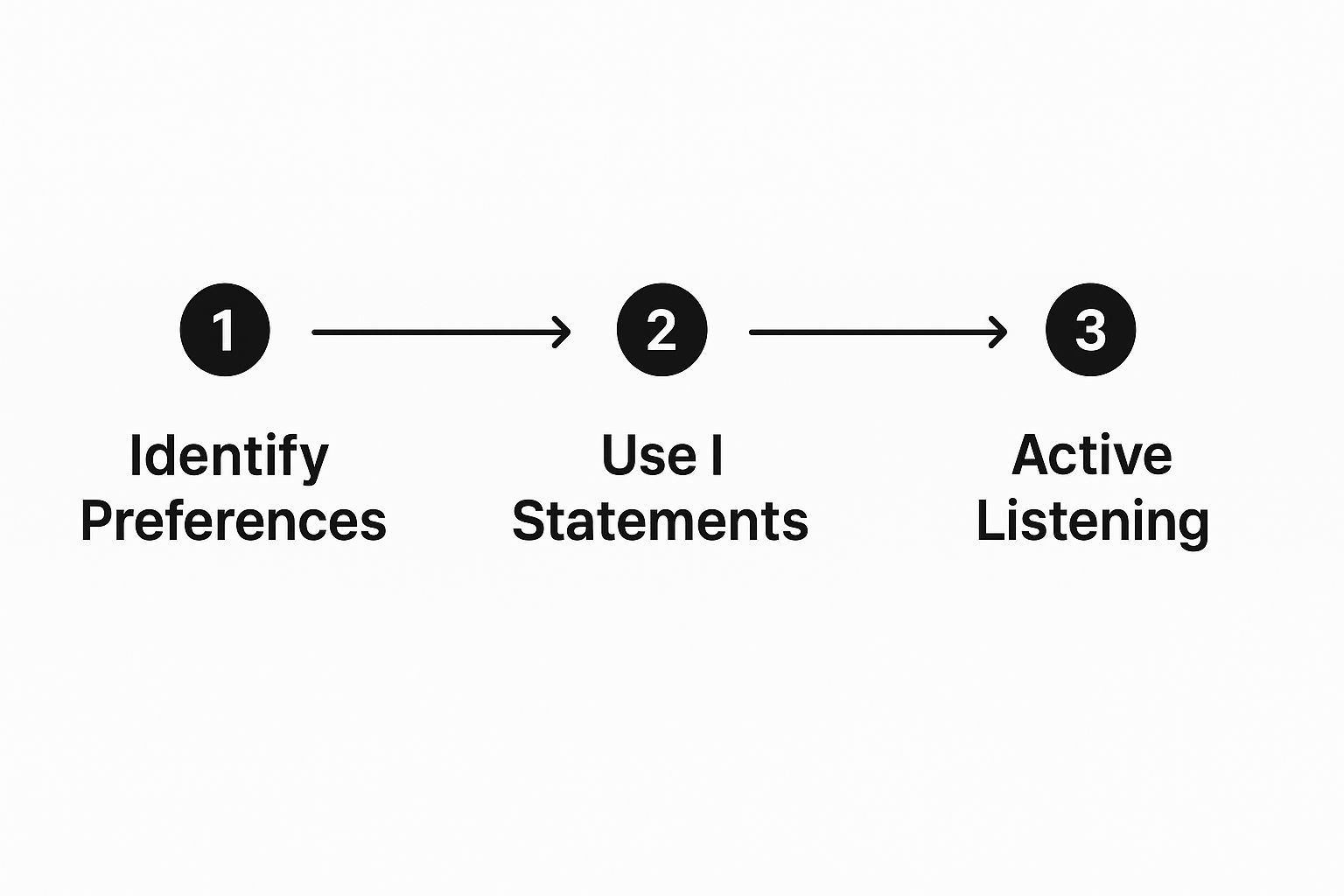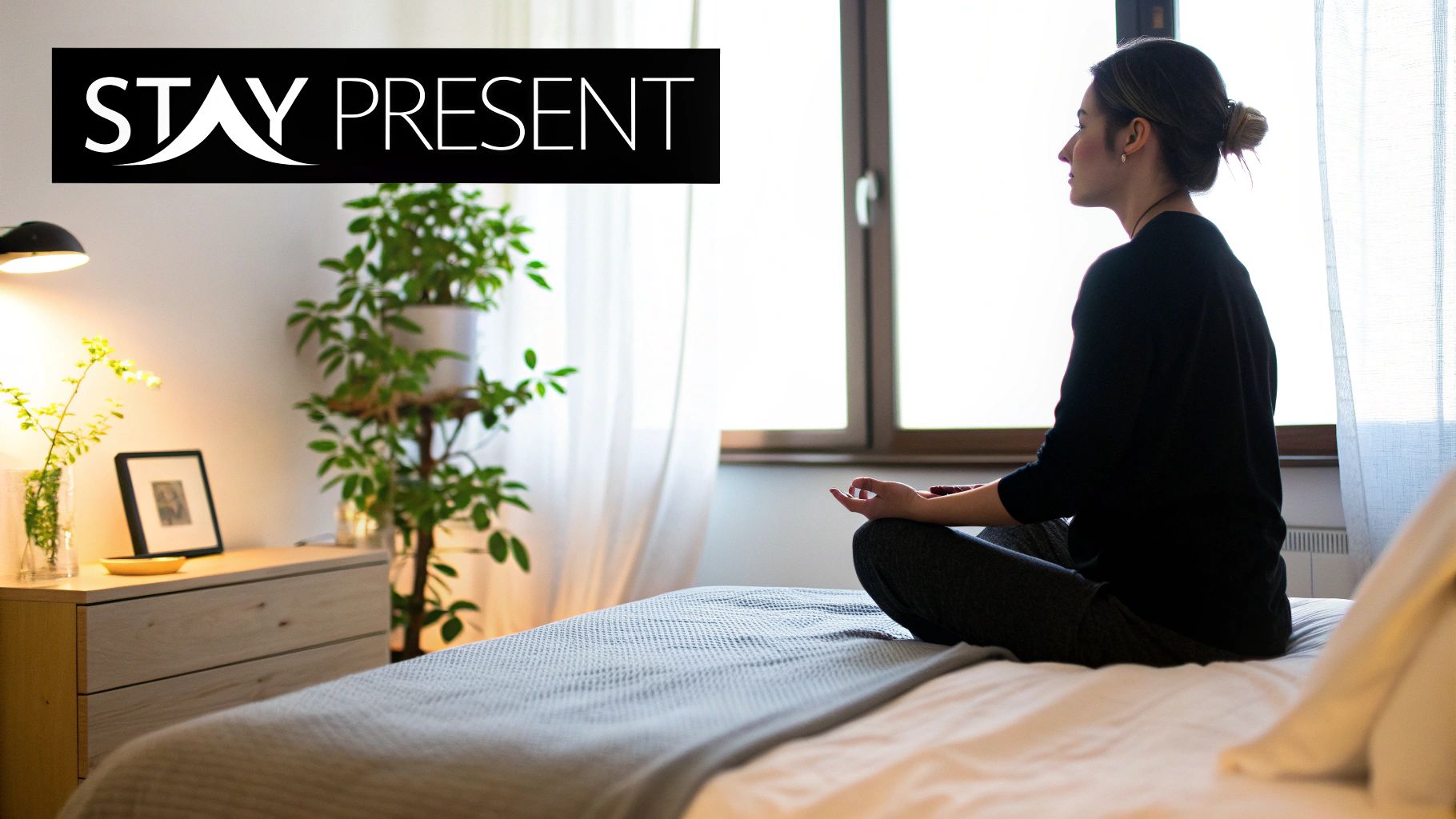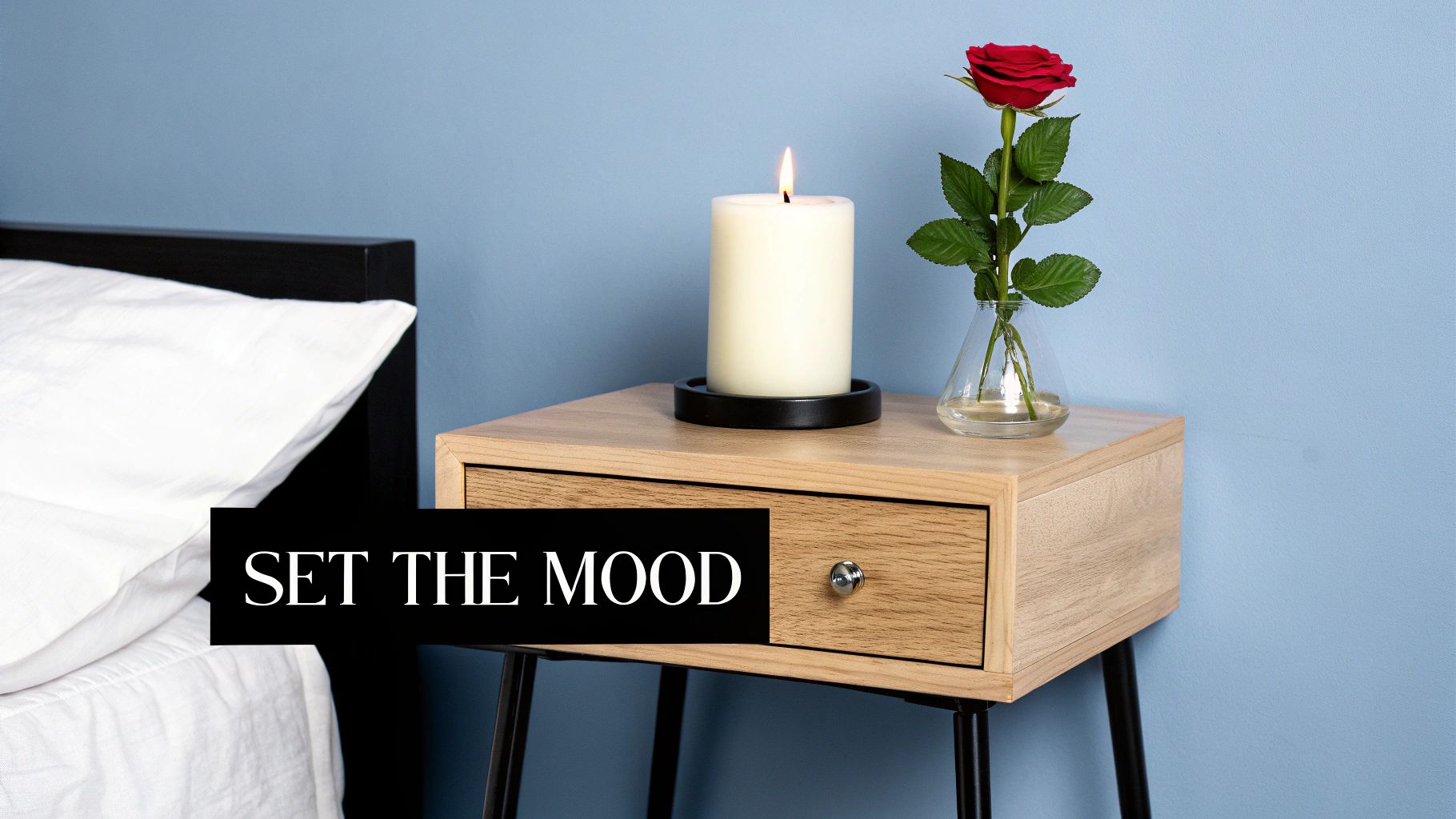The Truth About Sexual Confidence (And Why It Matters)

Let’s be honest: true sexual confidence isn’t about perfect positions or countless orgasms. It’s not the polished, performative sexuality we often see in the media. Real confidence in the bedroom comes from something much deeper: self-acceptance. This means embracing your body, your desires, and anything you might see as an imperfection.
It also means understanding that intimacy is a shared journey of exploration, not a performance to be evaluated.
This shift in perspective is key because it changes how we experience intimacy. When we let go of the pressure to perform, we open ourselves to real connection and pleasure. Worrying about how you look or whether you’ll orgasm can actually get in the way of enjoying the moment.
To dive deeper into this, check out resources that explore the nature of sexual confidence itself. Sexual Confidence
Knowing that everyone’s sexual experiences and timelines are different can be a major confidence boost. Understanding common sexual experiences can be helpful: By 2023, 32% of U.S. high school students had experienced intercourse, while 44% of teens aged 15-19 engaged in heterosexual oral sex, and almost 10% had experimented with anal sex.
For LGBTQ+ individuals, first same-sex experiences typically happen around age 18-20, highlighting that varied timelines are completely normal.
A 2024 global report from UNESCO found 85% of 155 countries now require sexuality education. However, there are still gaps in how these programs are put into practice, especially when it comes to including LGBTQ+ topics. This data confirms that sexual exploration varies widely, and good education, particularly programs addressing emotional aspects and diverse sexual orientations, links to a healthier self-image. For more detailed statistics, visit: https://actforyouth.org/adolescence/demographics/sexual-health.cfm . However, simply knowing the statistics isn’t the whole story.
Why Self-Acceptance Matters
Self-acceptance is the foundation of genuine sexual confidence. It’s about knowing you deserve pleasure and connection, no matter what. This means acknowledging and appreciating your unique desires, your comfort levels, and your physical attributes.
This inner security shines through, making you a more attractive and engaging partner. This, in turn, creates a positive cycle, further strengthening your confidence. This foundation of self-acceptance is crucial for putting the practical strategies we’ll discuss later into action.
Breaking Free From Performance Anxiety
Performance anxiety in the bedroom is a common experience. Many couples grapple with the pressure to perform, which can hinder intimacy. But why does this pressure arise, and how can couples overcome it? This section explores practical techniques developed by sex therapists to address anxiety before it impacts intimacy.
Understanding the Anxiety Cycle
Understanding the mechanics of performance anxiety is the first step towards overcoming it. The process flow below illustrates a typical anxiety cycle:

This process flow describes the cyclical nature of performance anxiety, starting with a trigger, followed by physical responses and negative thoughts. The cycle often culminates in avoidance or withdrawal, perpetuating the anxiety. Recognizing the initial trigger is key to breaking the cycle. By addressing the trigger early on, couples can prevent the escalation of anxiety and maintain intimacy. Learn more in our article about how to master….
Mindfulness and Reframing
Mindfulness can be incredibly helpful in intimate moments. By focusing on the present—your breath, senses, and your partner’s touch—you can redirect your attention away from anxious thoughts. For example, if you’re worried about your body image, try concentrating on the pleasurable sensations you’re experiencing.
This shift in focus, from evaluation to sensation, can effectively disrupt the anxiety cycle. Cognitive reframing is another valuable technique. This involves challenging negative thoughts and replacing them with more realistic and positive ones.
Addressing Specific Triggers
Different triggers call for different strategies. If body image is a concern, practicing self-compassion and focusing on the joy of connection can be beneficial. If orgasm pressure is causing anxiety, remember that intimacy is not solely about reaching climax. You might be interested in: How to master…
Performance anxiety has a direct impact on satisfaction. A 2025 study found that young Spanish women reporting higher sexual satisfaction experienced less inhibition from performance-related fears. Conversely, overthinking arousal decreased relationship satisfaction. These findings highlight that confidence is not about flawless performance, but about reducing pressure. Read the full research here .
To further illustrate common performance anxieties and their solutions, let’s look at the following table:
Common Performance Anxieties and Solutions
| Performance Anxiety | Impact on Confidence | Practical Solutions |
|---|---|---|
| Worrying about body image | Decreases self-esteem and comfort level | Practice self-compassion, focus on connection, and engage in positive self-talk |
| Pressure to achieve orgasm | Creates stress and reduces enjoyment | Reframe intimacy as more than just climax, explore different forms of pleasure |
| Fear of not satisfying partner | Leads to insecurity and withdrawal | Open communication, focus on mutual pleasure and exploration |
| Past negative sexual experiences | Triggers anxiety and avoidance | Seek professional help, practice mindfulness and self-compassion |
This table highlights the negative impact of various performance anxieties on confidence and provides practical solutions for each. Addressing these anxieties head-on through these methods can significantly improve intimate experiences.
Communication is Key
Open communication with your partner is essential. Sharing your anxieties and vulnerabilities can foster a deeper connection and trust. This also alleviates the pressure to perform and creates a more supportive and understanding environment for both of you.
Remember, genuine intimacy thrives on vulnerability and shared experience. This means embracing the imperfect reality of sex and prioritizing connection over performance. Open communication builds a stronger, more fulfilling intimate life.
The Conversation Blueprint: Talking About Desire

Open communication is the foundation of a fulfilling intimate connection. This involves honestly discussing desires, preferences, and boundaries with your partner. Many couples, however, find navigating these conversations challenging. This section explores how couples who are comfortable with their sexuality communicate their needs and desires, fostering mutual confidence in the bedroom.
Starting the Conversation
Initiating conversations about sex doesn’t have to be uncomfortable. It’s about finding the right moment and phrasing that feels natural for your relationship. For example, instead of bluntly asking “What do you want?”, try a softer approach. Something like, “I’ve been thinking about how much I enjoy [specific activity], and I was wondering if you feel the same way.”
This opens the door for discussion without putting pressure on your partner. Choosing the right setting is also important. A relaxed environment, free from distractions, encourages open and honest sharing, creating a positive and productive conversation.
Timing and Receptiveness
Just as important as what you say is when you say it. Avoid bringing up intimate topics when your partner is stressed or preoccupied. Instead, choose moments when you are both relaxed and connected. This could be a quiet evening at home, or after an enjoyable shared activity.
Being mindful of your partner’s emotional state shows respect and increases the likelihood of a receptive and positive response. Open communication, timed appropriately, builds intimacy and understanding.
Expressing Needs Without Pressure
Clearly expressing your needs is crucial, but it’s essential to do so without pressure. Using “I” statements can be particularly helpful. For example, instead of saying “You never do [activity]”, try “I would love to explore [activity] more.”
This focuses the conversation on your desires without placing blame. This subtle shift in language creates a more inviting and less defensive atmosphere, allowing your partner to consider your needs without feeling attacked or pressured.
Giving and Receiving Feedback
Feedback is a valuable component of sexual communication. However, feedback can sometimes be misinterpreted as criticism. To avoid this, focus on expressing appreciation for what you enjoy while gently suggesting alternatives. Try something like, “I love it when you [activity], and I think I would also really enjoy [alternative activity].”
This approach acknowledges your partner’s efforts and offers constructive suggestions, building confidence rather than diminishing it. Learning to give and receive feedback effectively strengthens intimacy and encourages exploration.
Non-Verbal Communication
Don’t underestimate the importance of non-verbal communication in the bedroom. Eye contact, touch, and body language can communicate a great deal. Paying attention to your partner’s cues can help you understand their desires and adjust your approach accordingly.
These subtle signals are vital for maintaining intimacy in the moment, providing real-time feedback and enhancing connection. Mastering non-verbal communication fosters a deeper level of understanding and mutual satisfaction.
Developing a personalized approach to sexual communication takes time and practice. By implementing these strategies, you can cultivate a more open, honest, and ultimately more fulfilling intimate life.
Embracing Your Body During Intimate Moments
Body image plays a significant role in how confident we feel in bed. This is true regardless of gender, shape, or size. True confidence in intimacy comes from appreciating what our bodies can experience, rather than fixating on how they look. This section offers practical strategies for embracing your body during intimate moments, drawing insights from body acceptance specialists and real couples.
Redirecting Critical Thoughts
Negative thoughts about our bodies can easily creep in during intimate moments. Learning to redirect these thoughts is essential for building confidence in the bedroom. One effective technique is to gently acknowledge the thought without judgment, then shift your focus to your physical sensations.
For example, if you find yourself thinking “My stomach looks bloated,” try focusing on the feeling of your partner’s hand on your skin. This practice helps ground you in the present moment, enhancing both pleasure and connection.
Practicing self-compassion outside the bedroom can also strengthen your overall body acceptance. This, in turn, makes it easier to manage critical thoughts during intimacy.
Focusing on Sensation, Not Appearance
A powerful way to build confidence during intimacy is to shift your attention from your appearance to your sensations. Try closing your eyes and concentrating on the textures, temperatures, and pressures you’re experiencing. This allows you to fully engage with the physical pleasure of the moment. It lessens the focus on perceived flaws.
This practice fosters a deeper connection with both your body and your partner. For instance, instead of worrying about how your thighs look, focus on the pleasurable sensation of their legs intertwined with yours. This simple shift in focus can dramatically transform your experience of intimacy.
Appreciating Your Body’s Capabilities
Instead of criticizing your body for not meeting unrealistic ideals, focus on all the wonderful things it can do. Appreciate the sensations it allows you to experience, the movements it enables, and the connection it fosters with your partner.
This shift in perspective cultivates gratitude and self-acceptance. Engaging in activities that celebrate your body’s abilities, such as dancing or yoga , can further reinforce this appreciation. This applies both inside and outside the bedroom, promoting a more positive relationship with your physical self.
Addressing Common Insecurities
Many people experience insecurities about specific parts of their bodies. Addressing these insecurities directly is key to cultivating greater confidence in bed. Open communication with your partner can be incredibly helpful in this process.
Sharing your vulnerabilities can create a stronger sense of trust and intimacy. However, it’s also important to work on self-acceptance. Remember that your partner is attracted to you as a whole person, not a flawless ideal.
Embracing your imperfections as part of what makes you unique can enhance your overall confidence. This also deepens your connection with your partner, fostering a more positive and accepting intimate experience for both of you.
Confidence-Building Tools Worth Your Attention
Building confidence in the bedroom isn’t just about positive self-talk. It’s also about having access to the right resources and tools. These can help foster a sense of security and comfort, paving the way for a more fulfilling intimate life. This section explores some confidence-building resources recommended by sex educators and therapists.
Educational Resources: Knowledge Is Power
One of the best ways to build confidence is through education. Understanding your body, your partner’s body, and the nuances of intimacy can significantly reduce anxiety and boost self-assuredness. Check out resources like How to master… to get started.
-
Books and Articles: Many resources cover topics such as anatomy, sexual health, communication techniques, and exploring different types of intimacy. These are great starting points for expanding your knowledge base and normalizing diverse experiences.
-
Online Platforms and Communities: Online communities provide safe spaces to ask questions, share experiences, and learn from others. These platforms offer valuable insights and support, fostering a sense of belonging and validation.
Sensory Exploration Products: Expanding Your Horizons
Sensory exploration products can be powerful tools for self-discovery and enhancing intimacy. They help individuals and couples understand their preferences, communicate their needs, and explore new dimensions of pleasure.
-
Stimulators: These tools allow individuals to explore their erogenous zones and discover what brings them pleasure. This self-knowledge can lead to greater confidence in communicating needs and desires to a partner.
-
Lubricants and Massage Oils: Enhancing physical sensations can increase enjoyment and reduce discomfort, promoting a more positive and confident attitude towards intimacy.
-
Sensory Toys: Toys designed for couples can introduce playfulness and exploration into intimate moments, fostering a pressure-free environment for discovery and connection.
Wellness Approaches: The Mind-Body Connection
Confidence is sometimes linked to overall well-being, including factors like your gut health . Beyond specific sexual wellness resources, broader wellness practices can contribute to a greater sense of self-assuredness and comfort in intimate settings.
-
Mindfulness and Meditation: These practices help individuals become more present in their bodies and reduce anxiety surrounding performance or body image.
-
Yoga and Exercise: Physical activity can improve body image and self-esteem, contributing to a more positive and confident attitude towards intimacy.
-
Therapy and Counseling: If deep-seated anxieties or past experiences are impacting your confidence, seeking professional support offers valuable tools and guidance for healing and growth.
Selecting and Using Resources Effectively
Choosing the right tools depends on individual needs and preferences. It’s crucial to approach these resources with an open mind and a focus on self-discovery. The growing sexual wellness market, valued at $120.93B in 2024 and projected to reach $132.77B by 2025, reflects a rising demand for these confidence-building tools. More information can be found in this report on sexual health products .
To help navigate the various options available, consider the following table:
Sexual Wellness Resources by Confidence Need
This table categorizes different types of sexual wellness products and resources based on the specific confidence challenges they address.
| Confidence Need | Resource Types | Benefits | Considerations |
|---|---|---|---|
| Low Self-Esteem | Therapy, Body-Positive Resources | Improves self-image and reduces negative self-talk | Requires ongoing effort and self-reflection |
| Anxiety about Performance | Mindfulness, Communication Exercises | Reduces performance pressure and fosters open dialogue | May require professional guidance |
| Difficulty Communicating Needs | Books, Articles, Online Forums | Provides language and strategies for effective communication | Requires consistent practice and open-mindedness |
| Lack of Exploration/Playfulness | Sensory Toys, Stimulators | Encourages experimentation and discovery of preferences | Requires a willingness to try new things |
| Physical Discomfort | Lubricants, Massage Oils | Enhances pleasure and reduces pain | Consider allergies and sensitivities |
This table highlights how various resources can address specific confidence challenges. From addressing low self-esteem through therapy and body-positive resources to overcoming communication barriers through books and online forums, there’s a wide range of options available.
Successful couples often use these tools to create pressure-free environments for exploration and communication. Remember, these resources are aids, not solutions. The real power lies in the mindset shifts that accompany their use: embracing vulnerability, prioritizing pleasure, and fostering open communication with your partner. By integrating these tools thoughtfully and intentionally, you can cultivate lasting confidence and create a more fulfilling intimate life.
Mindful Intimacy: Staying Present When It Matters Most

Sexual confidence can often grow when we are truly present. This section explores how mindfulness can enhance intimacy. Mindfulness is rooted in ancient wisdom and modern neuroscience. We’ll explore practical exercises to heighten bodily awareness, manage wandering thoughts, and deepen sensory experiences. These all contribute to a more confident and connected experience.
Heightening Bodily Awareness
The first step towards mindful intimacy is cultivating a deeper awareness of your physical self. This means paying attention to the sensations you experience, without judgment. Notice the texture of the sheets, the rhythm of your breath, or the subtle changes in your body’s temperature.
This awareness creates a stronger connection with your physical self. It lays the foundation for greater confidence and pleasure. For example, focusing on the feeling of your partner’s touch can amplify the sensations. This deepens intimacy and can quiet anxieties.
Managing Wandering Thoughts
It’s normal for your mind to wander during intimate moments. But these thoughts can sometimes detract from the experience. Mindfulness offers tools for gently redirecting your thoughts. This is done without self-criticism.
Imagine your thoughts like clouds. Acknowledge them without judgment. Gently guide your attention back to your physical sensations or your partner. This practice grounds you in the present moment, enhancing intimacy and connection.
Deepening Sensory Experiences
Mindful intimacy encourages a deeper exploration of your senses. Pay close attention to the sights, sounds, smells, tastes, and textures. This heightened awareness amplifies pleasure. It creates a more immersive and satisfying experience.
Think of it like savoring a meal. You take your time to appreciate every flavor and texture. Similarly, mindful intimacy involves savoring every sensation. This enhances your pleasure and connection with your partner.
Mindful Intimacy in Practice
Using these techniques can be powerful. Start by practicing mindfulness in your daily life. This could involve mindful breathing exercises, body scans, or simply paying closer attention to your senses. See more on how to master…
These daily practices build a foundation of mindful awareness. This naturally carries over into the bedroom. During intimacy, try focusing on your breath, your partner’s touch, or the pleasurable sensations.
If your mind wanders, gently redirect your attention back to the present. Mindful intimacy is a journey. Be patient with yourself and enjoy the process of deepening your connection with yourself and your partner.
Learning From Confident Couples
Couples who have cultivated mindful intimacy report greater satisfaction and connection. They use these practices to navigate life’s challenges. They maintain intimacy even when faced with stress.
These couples show that how to be more confident in bed isn’t about an external ideal. It’s about cultivating a deeper connection with yourself and your partner. Mindful intimacy allows for a more fulfilling experience. It fosters a stronger bond between partners.
Building Lasting Confidence Through Life’s Changes
Sexual confidence isn’t static; it changes throughout life. Relationships grow and evolve, our bodies change, health issues can arise, and life has a way of throwing unexpected challenges our way. This means building confidence in the bedroom is an ongoing process. This section explores how to maintain and rebuild that confidence during these inevitable life shifts.
Adapting to Changing Bodies
Our bodies change over time. It’s a natural part of life. Pregnancy, childbirth, weight fluctuations, and the aging process all bring physical changes. These shifts can impact body image and, as a result, sexual confidence.
It’s important to embrace these changes as a normal part of life. Focusing on what your body can do—experience pleasure, connect with a partner—rather than solely on its appearance, can significantly boost confidence. Learn more in our article about how to master… . For example, after childbirth, a woman’s body may be different, but it has also accomplished something incredible. Celebrating these changes, rather than focusing on perceived flaws, can foster a healthier body image and enhance intimacy.
Navigating Health Challenges
Health issues can also affect sexual confidence. Chronic illnesses, injuries, and medications can all impact desire, arousal, and physical ability. Open communication with your partner is essential during these times.
Talking openly about limitations and exploring alternative ways to connect intimately can strengthen your bond and maintain a fulfilling sex life. This might involve focusing on non-penetrative intimacy, exploring sensual massage, or simply cuddling and talking. The key is to adapt and find new ways to express love and connection.
Reconnecting After Distance
Life transitions, such as career changes, the demands of parenting, or periods of stress, can create distance between partners. This distance can affect intimacy and diminish confidence in the bedroom. Making a conscious effort to reconnect is vital.
Scheduling regular date nights, engaging in shared hobbies, and prioritizing open communication can reignite the spark and rebuild intimacy. This reconnection takes time and patience. It’s about rediscovering each other and building a stronger foundation for a fulfilling intimate life. Small gestures of affection and appreciation can be powerful tools in rebuilding intimacy and fostering a sense of closeness.
Communicating About Changing Needs
As we journey through life, our sexual needs and desires naturally evolve. What felt good in our twenties might not feel the same in our forties or fifties. It’s essential to communicate these changing needs to your partner.
Creating a safe space for open and honest conversations about desires, fantasies, and boundaries fosters mutual understanding and strengthens intimacy. This might involve talking about new things you’d like to try, revisiting old favorites, or simply acknowledging that your preferences have shifted.
Maintaining a Growth Mindset
A growth mindset is crucial for navigating the fluctuations in sexual confidence. This means viewing challenges as opportunities for growth and learning. It’s about understanding that setbacks are normal and that confidence can be rebuilt.
Embracing a growth mindset allows you to adapt to life’s changes with resilience. It empowers you to explore new dimensions of intimacy and maintain a positive outlook on your sexual journey. Remember, confidence isn’t about being perfect; it’s about embracing the journey and continuing to learn and grow together.
The post Boost Your Confidence in Bed: Proven Tips to Feel More Secure appeared first on G Spot 101 .
Intimate Tickles found this article quite interested, and we thought you might to. We give all the credit for this article to gspot. Click Here To Read This Article From It's Original Source